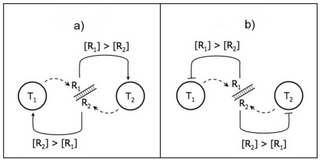Molecular Programming Project: Difference between revisions
| Line 12: | Line 12: | ||
== Objectives == | == Objectives == | ||
{| align=right width=40% border=1 | |||
|- | |||
| [[Image:rate-regulator.png|320px]]<br> | |||
Schematic for a negative rate regulator (a) and a positive rate regulator (b). The negative rate regulator works by creating two transcripts that are complementary to teach other and also contain sequences complementary to an activator strand for the "genelets" T1:A1 and T2:A2. If one of the templates produces excess transcripts compared to the other, the excess strands will strip off the activators, downregulating the appropriate genelet. The positive rate regulator works in a similar fashion, except the outputs from the genelets cross upregulate. | |||
|} | |||
The long term goal of the Molecular Programming Project is to establish a fundamental approach to the design of complex molecular and chemical systems based on the principles of computer science. The focus of our study, molecular programs, are collections of molecules that may perform a computation, fabricate an object, or control a system of molecular sensors and actuators. This project aims to develop tools and theories for molecular programming--such as programming languages and compilers--that will enable systematic design and implementation in the laboratory. | The long term goal of the Molecular Programming Project is to establish a fundamental approach to the design of complex molecular and chemical systems based on the principles of computer science. The focus of our study, molecular programs, are collections of molecules that may perform a computation, fabricate an object, or control a system of molecular sensors and actuators. This project aims to develop tools and theories for molecular programming--such as programming languages and compilers--that will enable systematic design and implementation in the laboratory. | ||
Revision as of 19:41, 6 April 2009
This is a joint project with Erik Winfree (PI), Shuki Bruck, Eric Klavins (UW), Niles Pierce and Paul Rothemund, funded by the NSF Expeditions program. This page primarily describes the work done in Richard Murray's group; see the MPP homepage for a description of the complete project.
Current participants:
|
Past participants: |
Objectives
The long term goal of the Molecular Programming Project is to establish a fundamental approach to the design of complex molecular and chemical systems based on the principles of computer science. The focus of our study, molecular programs, are collections of molecules that may perform a computation, fabricate an object, or control a system of molecular sensors and actuators. This project aims to develop tools and theories for molecular programming--such as programming languages and compilers--that will enable systematic design and implementation in the laboratory.
Current work includes:
- Developing in vitro transcriptional circuits capable of equalizing the rates of production of transcripts (Franco, Chen)
- Modeling and analyzing the role of crosstalk in biological circuits (Barmpoutis)
- Modeling, characterization and interconnection of transcriptional oscillators (Franco, Winfree)
Publications
- Design of insulating devices for in vitro synthetic circuits, Elisa Franco, Domitilla Del Del Vecchio, Richard M Murray. Conference on Decision and Control (CDC), 2009.
- Design and performance of in vitro transcription rate regulatory circuit, Elisa Franco, Richard M Murray. Conference on Decision and Control (CDC), 2008.
